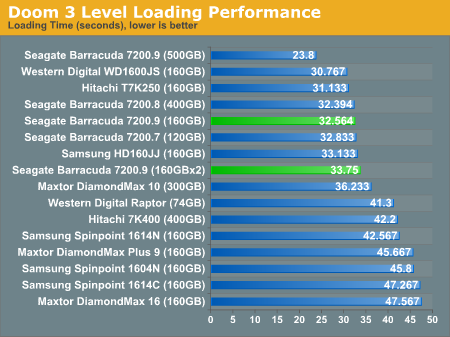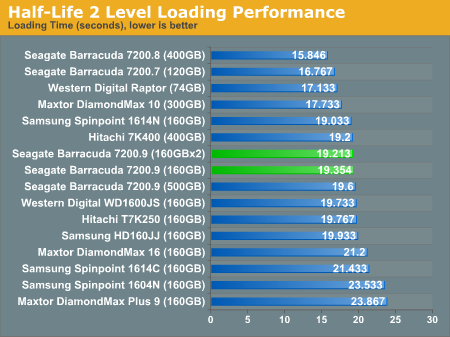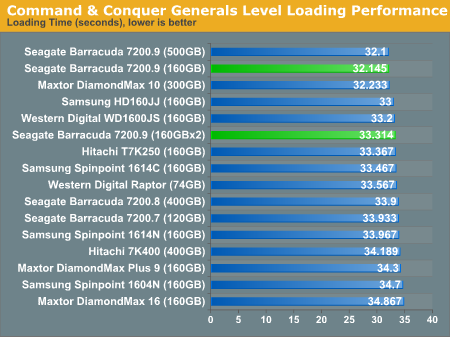Seagate 7200.9 160GB: The Highest Platter Density to Date!
by Purav Sanghani on January 31, 2006 10:29 PM EST- Posted in
- Storage
Real World Tests - Multitasking Performance
To provide a real world example of multitasking, we run Outlook and import 450MB of emails into an account. We then time how long it takes our benchmarking utility to zip a single 300MB file. To compare our results, we calculate the difference between the multitasked process and the single task file zip process.
Real World Tests - Application Load Times
In our Application Load Time tests, we measure the time that it takes for each application to startup. For example, our benchmarking tool begins the stopwatch as soon as PhotoShopCS.exe is run and stops after the application has finished loading all of the plug-ins and filters and shuts down. We take the average of 3 runs with system reboots and hard disk defragmentations before each test run.
The higher density platters of the 160GB unit prove to perform slightly faster when loading the Office 2003 application suite as well as the Photoshop CS imaging software. RAID-0 does not help here at all, but does very little to hurt.
Game Level Load Times
Our Game Level Loading Time tests include two of the latest games: Doom 3 and Half-Life 2. Because of their high resolution textures and the large levels, the loading time for the levels of each game are long enough to help show a difference between each drive.
We have also included an older strategy game, Command & Conquer: Generals, because of its longer level load times as well. Though the game is a couple of years old, it still proves to be a good measure of data loading performance.
To provide a real world example of multitasking, we run Outlook and import 450MB of emails into an account. We then time how long it takes our benchmarking utility to zip a single 300MB file. To compare our results, we calculate the difference between the multitasked process and the single task file zip process.
| Outlook + Zip a 300MB File Within Drive | ||||
| Multitasked | File Zip Only | % Difference | ||
| Seagate 7200.9 160GB | 78.624 | 65.715 | 19.6% | |
| Seagate 7200.9 160GB (2-Drive, RAID-0) | 68.546 | 58.693 | 16.8% | |
| Hitachi T7K250 160GB | 79.815 | 65.641 | 21.6% | |
| Samsung HD160JJ 160GB | 73.554 | 61.068 | 20.4% | |
| Western Digital WD1600JS 160GB | 74.371 | 61.182 | 21.6% | |
| Seagate 7200.9 500GB | 69.512 | 59.785 | 16.3% | |
Real World Tests - Application Load Times
In our Application Load Time tests, we measure the time that it takes for each application to startup. For example, our benchmarking tool begins the stopwatch as soon as PhotoShopCS.exe is run and stops after the application has finished loading all of the plug-ins and filters and shuts down. We take the average of 3 runs with system reboots and hard disk defragmentations before each test run.
| Application Load Times (average, seconds) | |||||
| PhotoShop CS | Word 2003 | Excel 2003 | Access 2003 | PowerPoint 2003 | |
| Seagate 7200.9 160GB | 7.454 | 1.109 | 1.125 | .968 | 1.109 |
| Seagate 7200.9 160GB (2-Drive, RAID-0) | 7.544 | 1.171 | 1.140 | 1.125 | 1.000 |
| Hitachi T7K250 160GB | 7.984 | 2.375 | 2.609 | 2.766 | 2.109 |
| Samsung HD160JJ 160GB | 8.601 | 2.554 | 2.887 | 3.115 | 2.245 |
| Western Digital WD1600JS 160GB | 8.938 | 2.469 | 2.562 | 2.484 | 2.438 |
| Seagate 7200.9 500GB | 8.024 | 1.687 | 1.718 | 1.640 | 1.593 |
The higher density platters of the 160GB unit prove to perform slightly faster when loading the Office 2003 application suite as well as the Photoshop CS imaging software. RAID-0 does not help here at all, but does very little to hurt.
Game Level Load Times
Our Game Level Loading Time tests include two of the latest games: Doom 3 and Half-Life 2. Because of their high resolution textures and the large levels, the loading time for the levels of each game are long enough to help show a difference between each drive.
We have also included an older strategy game, Command & Conquer: Generals, because of its longer level load times as well. Though the game is a couple of years old, it still proves to be a good measure of data loading performance.













23 Comments
View All Comments
PuravSanghani - Wednesday, February 1, 2006 - link
Hey everyone,The thermal and acoustic results are now in the graphs. We pulled the article last week because of the missing data. Enjoy!
Purav
Mr Perfect - Wednesday, February 1, 2006 - link
Well, the thermals arn't anything special, but the accustics are the quietest ones on the cart. :) Might not be important to some, but it's got me interested.Lord Raiden - Friday, January 27, 2006 - link
Thats what I was exactly thinking. A mistake? Or was it deliberately done?In my humble opinion, Seagate has the most respected drivsin the market for so many years so far. I sense some strange shifting of the mood in some reviewers articles around the world favouring the other companies in the reviews. Like Chip, the most selling, most respected magazine has monthly tables with TOP10 drives and seagate scores 9th out of 10 while his scores in particular cateories are comparative with top three every month... i laugh at that table as it is clear evidence of them being not really fair in judgements...
Anandtech is a respectable site and to believe they wasted a whole page talking about temperature where the drive discussed won't appear at all is simply strange.
:-) Maybe they got confused whether to add temperatures of two drives in RAID or make an average out of them... ;-)
Lord Raiden - Friday, January 27, 2006 - link
Ooops,... like CHip, the most selling, most respected magazine in my country...
ATWindsor - Friday, January 27, 2006 - link
Yeah, that was one of the most interesting things to know, I want to now how warm and noisy it is...Ender17 - Friday, January 27, 2006 - link
"We are itching to see the performance of a RAID-0 array with Raptors!"Didn't Anand already write an article on that back in 2004?
http://www.anandtech.com/storage/showdoc.aspx?i=21...">http://www.anandtech.com/storage/showdoc.aspx?i=21...
Western Digital's Raptors in RAID-0: Are two drives better than one?
Scarceas - Saturday, February 4, 2006 - link
They need to compare a single drive not just to a 2 drive raid array, but 3 and 4 drives as well. And then u start getting into controller performance; it can get laborious.Xenoterranos - Friday, January 27, 2006 - link
I think the point is that those tests were done with PATA drives, where a single drive comes close to maxing up the peak theoretical bandidth. With SATA II drives, even two raptors don't come close to the max theoretical bandwidth, so you have a much bigger road to run them on. The point made in that original article still stands: By doing raid-0, you're doubling the chance of data failure and doubling your cost for only a marginal increase. And to most people, loading Quake 10 seconds faster isn't worth 600+ bucks.(now, playing it a 10 fps higher on the other hand...)andrep74 - Wednesday, February 1, 2006 - link
"With SATA II drives, even two raptors don't come close to the max theoretical bandwidth"Especially since they're each on their own controller. Unless you're putting two drives on the same cable, not even PATA drives can come close to saturating the controllers (where I use the term "close" to mean ~90-95%). Most drives cannot even read at 70MB/sec (unless we're talking about solid-state drives). From buffer to controller is another issue entirely, but that rarely has a noticeable impact on overall performance, much less RAID performance.
Live - Friday, January 27, 2006 - link
Well I still believe that the theoretical/syntactical performance is all that really will go up in a Raid-0. Storagereview tester Eugene made this post about Raid-0 in connection to his review of the new 150gb raptor:http://forums.storagereview.net/index.php?s=&s...">http://forums.storagereview.net/index.p...c=21621&...
If Anandtech now takes the position that sata/sata2 somehow changed the disadvantages/advantages of Raid-0 on the desktop I really think they should do more to prove it then just a few lines in a hard drive review. Does Anand agree with the conclusions about Raid stated in this review?